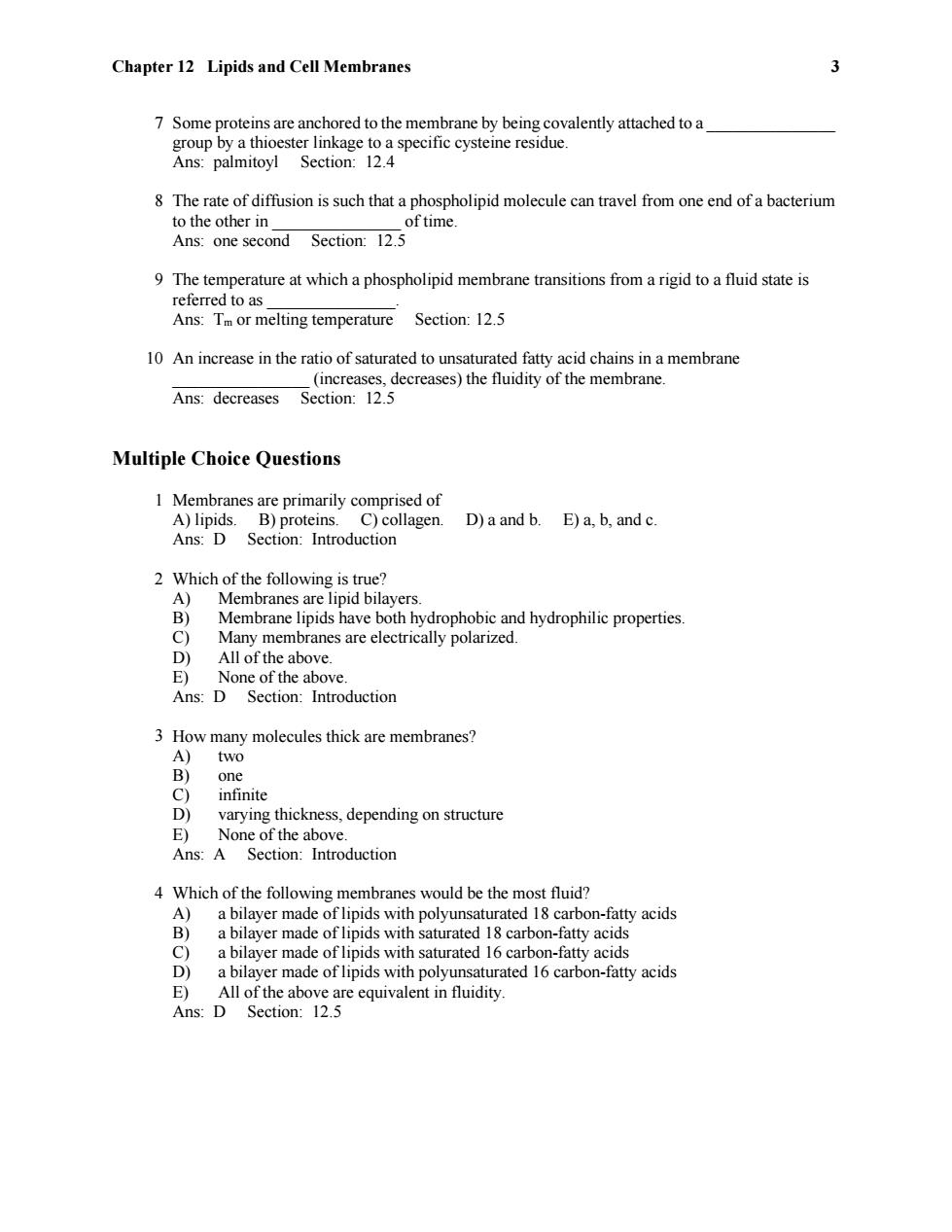正在加载图片...

Chapter 12 Lipids and Cell Membranes 3 7 Some proteins are anchored to the membrane by being covalently attached to a group by a thioester linkage to a specific cysteine residue. Ans:palmitoyl Section:12.4 8 The rate of diffusion is such that a phospholipid molecule can travel from one end of a bacterium to the other in oftime. Ans:one second Section:12.5 9 The temperature at which a phospholipid membrane transitions from a rigid to a fluid state is referred to as Ans:Tm or melting temperature Section:12.5 10 An increase in the ratio of saturated to unsaturated fatty acid chains in a membrane (increases,decreases)the fluidity of the membrane. Ans:decreases Section:12.5 Multiple Choice Questions 1 Membranes are primarily comprised of A)lipids.B)proteins.C)collagen.D)a and b.E)a,b,and c. Ans:D Section:Introduction 2 Which of the following is true? A)Membranes are lipid bilayers. B)Membrane lipids have both hydrophobic and hydrophilic properties C) Many membranes are electrically polarized. D) All of the above. E)None of the above. Ans:D Section:Introduction 3 How many molecules thick are membranes? A) two B) one C) infinite D) varying thickness,depending on structure E)None of the above. Ans:A Section:Introduction 4 Which of the following membranes would be the most fluid? A)a bilayer made of lipids with polyunsaturated 18 carbon-fatty acids B)a bilayer made of lipids with saturated 18 carbon-fatty acids C)a bilayer made of lipids with saturated 16 carbon-fatty acids D)a bilayer made of lipids with polyunsaturated 16 carbon-fatty acids E)All of the above are equivalent in fluidity. Ans:D Section:12.5Chapter 12 Lipids and Cell Membranes 3 7 Some proteins are anchored to the membrane by being covalently attached to a _______________ group by a thioester linkage to a specific cysteine residue. Ans: palmitoyl Section: 12.4 8 The rate of diffusion is such that a phospholipid molecule can travel from one end of a bacterium to the other in _______________ of time. Ans: one second Section: 12.5 9 The temperature at which a phospholipid membrane transitions from a rigid to a fluid state is referred to as _______________. Ans: Tm or melting temperature Section: 12.5 10 An increase in the ratio of saturated to unsaturated fatty acid chains in a membrane ________________ (increases, decreases) the fluidity of the membrane. Ans: decreases Section: 12.5 Multiple Choice Questions 1 Membranes are primarily comprised of A) lipids. B) proteins. C) collagen. D) a and b. E) a, b, and c. Ans: D Section: Introduction 2 Which of the following is true? A) Membranes are lipid bilayers. B) Membrane lipids have both hydrophobic and hydrophilic properties. C) Many membranes are electrically polarized. D) All of the above. E) None of the above. Ans: D Section: Introduction 3 How many molecules thick are membranes? A) two B) one C) infinite D) varying thickness, depending on structure E) None of the above. Ans: A Section: Introduction 4 Which of the following membranes would be the most fluid? A) a bilayer made of lipids with polyunsaturated 18 carbon-fatty acids B) a bilayer made of lipids with saturated 18 carbon-fatty acids C) a bilayer made of lipids with saturated 16 carbon-fatty acids D) a bilayer made of lipids with polyunsaturated 16 carbon-fatty acids E) All of the above are equivalent in fluidity. Ans: D Section: 12.5